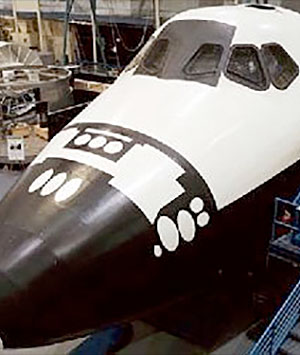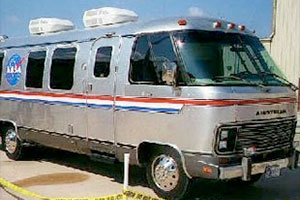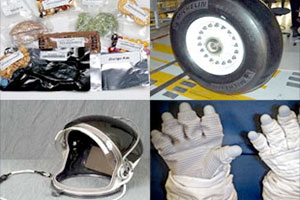September 14, 2009 — From spacesuits to space food, full scale simulators to the van used to drive its crews to the launch pad, NASA has begun the process of divvying up the equipment used to support its soon-to-be retired space shuttle fleet to U.S. museums and schools.
The space agency announced Monday a partnership with the General Services Administration (GSA), which directs the sale of government surplus, to create a website where qualifying federal agencies and public organizations could preview shuttle artifacts as they become available and express their interest in obtaining them for display.
NASA defines artifacts as "unique objects that represent the history of the science and technology of aeronautics and astronautics." For the purposes of this program, flight status was used as a first-cut criterion for determining the significance of potential artifacts, with higher importance being placed on hardware and memorabilia that flew, over flight spares and training or development equipment.
Artifacts included in this first offering include items from NASA's Kennedy Space Center in Florida, as well as the Johnson Space Center in Houston, Texas. Access to the list itself is presently limited to only eligible recipients.
Not included though, are the three space shuttle orbiters themselves, which were the focus of a separate request issued by the agency earlier this year. NASA intends to offer Discovery to the Smithsonian Institution but has yet to decide the final disposition for Atlantis and Endeavour.
The prescreening website, which debuted September 1 to NASA visitor centers and the Smithsonian's National Air and Space Museum in Washington, DC, which under a long standing agreement has first choice of the artifacts, opens October 1 to public museums and state-sponsored educational facilities for an additional 60 days. During this time, the organizations may view the available equipment and apply for their possession.
NASA is offering the artifacts for free, though recipients are responsible for packaging and shipping costs. The items will become the property of the chosen organization though according to NASA, all requests are subject to the needs of their on-going programs, including future shuttle missions and the Constellation spacecraft planned as the replacement for the orbiters.
The initial online catalog lists only a few hundred artifacts out of potential for thousands of items that may become available, including large hardware such as space shuttle main engines to smaller hardware pieces that have flown in space. NASA plans to roll out more artifacts in batches or waves as information about the items is collected and formatted for prescreening.
Outside the other federal agencies and the Smithsonian, museums and schools desiring items must contact their GSA-run state surplus programs to request access to the website.
A panel established by NASA will review the requests for the financial ability (to cover the shipping fees), display capability and "other established criteria" before deciding who will receive the artifacts. Awardees will have 15 days to pick up the artifact once NASA issues a transfer order.
The first round of decisions will begin after November 30 when the current prescreening period closes. Though the recipients may be selected sooner, some of the artifacts still in use by the shuttle program will not be available for transfer until after the orbiters stop flying in the next year or so.
For more information, see the GSA "NASA Space Shuttle Program Historic Artifacts Prescreening" website. |
|

A space shuttle simulator is among the artifacts NASA has put up for grabs to museums and schools. (NASA/GSA)

NASA's modified Airstream transport van, the AstroVan, used to take astronauts to the launch pad, is also included. (NASA/GSA)

Some the items are available in quantity, including space food, spacesuit components and shuttle tires. (NASA/GSA) |
